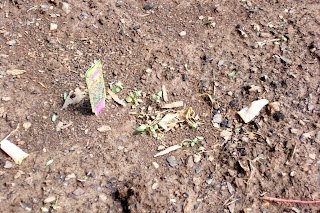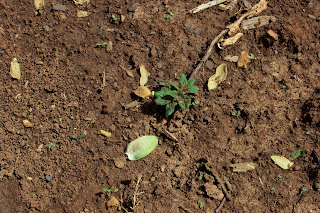
I ate my first sugar snap pea from my garden today. Crispy and delicious. And tiny. I must be patient.
My mother is a flower gardener and I agree, flowers are beautiful, but I think vegetables are every bit as beautiful and nothing is lovelier than the sugar snap pea.

The decision to sow seeds directly into the ground turned out to be a good one for me. I understand the principles of Grow-Biointensive gardening and plan to implement more as I gain more experience. Planting seeds and then transplanting seedlings is the most efficient way to garden. You use less water and you have a greater yield for the energy and resources expended. But sowing directly is better than no garden at all and probably better than buying
all of your transplants.
With the exception of my swiss chard, everything I planted in late March has done well, especially my potatoes.

They are growing more like weeds than potatoes!
Tennzen, in her blog, indicated that she planted her potatoes in tires. I didn't have any tires and I was having trouble keeping earth mounded up around the potato plants. So my muscle from the double dig (my husband), who is also very handy, built a box around them.

We filled the box with dirt and then topped it off with straw--on the advice of another gardener who claimed this was the easiest way to grow potatoes. As I understand it, the potatoes will form in the dirt and straw surrounding the potato plants. In mid to late June, the plants will die. We'll wait 2 weeks and then remove the boards and pull the potates out of the straw/dirt mixture. Keep your fingers crossed.
Our lettuce and collards are doing equally well. I think the collards are soon ready to harvest and the romaine lettuce is starting to form heads. You can see the second potato box in the lefthand corner of the picture. Here's an interesting side note: In the Grow Biointensive method, they argue that certain vegetables can actually inhibit growth if planted next to one another. Specifically, they recommend NOT planting peas and potatoes together. The potatoes to the left
were planted beside the peas, however, because I happened to have a little extra room there and some extra potato pieces. The potatoes in the box next to the peas are not as big as the ones further away! So maybe there is something to this companion planting...

One more thing on potatoes...If you read earlier entries in this blog, you'll remember "The Great Potato Controversy": To chit or not to chit and to cut or not to cut. Well, I cut and sort of chitted and then waited way too long to plant after I cut. Apparently, it's impossible to screw up potatoes. Famous last words. I'll let you know when the bugs get them!
Now, you'll also remember that I have almost no tranplants from the seeds that I started. So today I went to the Co-op and bought some plants. All I had of my own to plant were 2 cucumber plants and 4 teeny tomato plants that I hope are Cherokee Purples. Fortunately, the Co-op carries some heirlooms so I picked up two heirloom Bradleys, 2 Pink Ladies, 2 Rutgers, and 1 Mr. Stripey (not an heirloom, but who can resist a name like that?) While I was at it, I grabbed 4 bell peppers (2 red and 2 green), basil, rosemary, thyme, and parsley. I also snagged a lavender plant and a mosquito plant that smells like citronella. I planted some more seeds, too, sowing directly into the ground. I actually planted some flowers--Early Sensation cosmos, State Fair zinnias, and calendula resina. I also planted Blue Lake snap beans, Mississippi Silver peas, and Jackson Wonder butter beans. My husband pointed out to me that I don't like butterbeans (he does, so you would think he wouldn't complain) and I told him I like them fresh. We'll see.

Citronella, lavender, parsley, & thyme plus 2 red bell peppers; About an hour after I planted, someone (maybe a bird?) shredded the lavender. geez. I planted this where my swiss chard used to be. I planted the swiss chard in late March and in 2 months it had grown only about 5 inches tall. Something wrong there! When I got my delivery of vegetables this week from Doe Run Farm and saw their gorgeous foot long swiss chard I knew it was time to put mine out of its misery.

Thanks to the Co-op, there will be tomatoes. The 4 tiniest tomato plants with no basket around them yet are the transplants I started from seed.
More reflections on the grow biointensive method...This method calls for the gardener to plan every inch of space in his or her garden, start every single plant from seed and then transplant, and use home processed compost to enrich the soil, along with the double dig. It makes a tremendous amount of sense to me--it's smart and sustainable, but I haven't been able to fully or even partially implement the plan. First, the gardening season starts while I'm still crazy busy with school so planning (and implementing!) is tough. Second, I'm the world's worst composter. Never have been to produce beautiful, useable compost. I get either slime or my composter gets indigestion and stages a sit down strike, refusing to compost. As a result, I had to buy more bags of Miracle-Gro ogranic garden soil than I care to admit. Third, while I appear to have the gift of germination, I have not yet gotten the hang of turning those tiny 2 inch seedlings into strong, viable, transplantable seedlings. As a result, I've had to sow seed directly and have not used my garden space efficiently, so I have seeds I haven't planted--no space for them. I'm thinking about buying (yet another purchase!) some containers so I can plant my Waltham Butternut Squash and my heirloom Seminole pumpkin. The corn will have to wait until next year. And finally--and here's my greatest weakness--I buy seeds because I like the names. And so I have too many--more than I'll ever use. Surely, there's some place in sustainable gardening for plants with beautiful names.
























